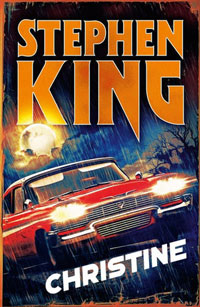(May 24 – Jun 9)

While reading Christine I found my mind routinely flicking back to Cujo—a novel (and one presumes not the only one) that Stephen King wrote while in a thick alcoholic haze and claims no memory of writing. It is a book where Stephen King The Author clearly took over the day’s business and got the job done.
In similar fashion, Christine reads a lot like Stephen King on autopilot and yet the results are so very different. Cujo, while a grim and challenging read, is chock full of deep characterisations, thematically linked sub-plots, and some genuinely bold twists and turns. By contrast, Christine comes across more like someone attempting to write a Stephen King novel, while possessing little more than King’s surface ability to take everyday objects and turn them into sources of horror, and none of his raw talent for backstory, characterisation and sense of place.
There’s barely enough plot in Christine for a short story—it would likely have made a perfect fourth novella for Different Seasons, where it could have been a tight, efficient, standout horror tale. Instead it’s a bloated, indulgent and largely empty novel that demands 700 pages of your attention and gives very little back in return.
Let’s be clear, tho: in many ways it is a classic Stephen King horror novel. You’ve got the everyday object (in this case a car) getting possessed by evil forces; you’ve got a domineering mother; you’ve got lovingly crafted descriptions of death scenes and corpses. It’s familiar territory and, inevitably, stands in marked contrast to the arguably more experimental novels he had published previously. It’s Stephen King being very conscious of what people (and his publishers) expect from a Stephen King novel and trying to deliver exactly that.
The Adaptations
There is one adaptation of Christine: a 1983 movie directed by John Carpenter. Unfortunately, I can’t say in good conscience that it does much to improve on the book despite some interesting changes here and there (mostly to tighten up the structure and avoid some of the book’s more egregious meandering). The movie finds Carpenter mostly in journeyman mode, possibly as a consequence of not working on his own material, but he still manages to inject a few nice touches. For example, there is a stunning sequence of Christine on fire, and the effects of the car regenerating are particularly effective.
For me, however, the most noteworthy aspect of the movie is that it stars the actor I shall forever refer to as Ghostbusters Gum Guy—you know, the one who spits his gum out after Bill Murray gives him an electric shock? His hair, if anything, is even bigger in this movie. It’s quite spectacular. Obviously worth the price of admission alone.
In a strange piece of timing, literally the day after I finished the novel the interwebs were all ablaze with news that Bryan Fuller was working on a new adaptation with Blumhouse. I’ll be particularly curious to see if they can inject any more depth into this one.
The Reading
You’d think, given my above review, that I would have struggled through Christine, but the opposite is true. While it’s overly long, it’s a very undemanding read: It’s Stephen King lite and while I didn’t think much of it, it didn’t particularly drag and I found myself reading an easy 50 pages or so each night. This comes in marked contrast to Cujo which, on reflection, is a far better book but is, so far, the only one I found myself struggling to complete.
Christine is one of the King novels that I read way back in my teen years. Just about the only thing I remember from it is the jarring change in narrative voice. For those who are unfamiliar: the first 250 pages or so are in first person (the first time, I think, King has written a novel in first person); then our narrator lands himself in hospital, so we switch to omniscient third person narrator for a large chunk of proceedings; finally, the last 150 pages reverts to first person again.
I was fascinated by this when I first read it, and it’s something that’s stuck with me over the years. It seemed so clumsy … and yet it was Stephen King, so maybe it was secretly brilliant? Now that I have a little experience of writing under my own belt, I was keen to see how the narrative shift would land with me this time.
Well, firstly, it didn’t seem that jarring. There comes the same point where our trusted narrator starts being referred to in the third person, but the actual transition in narrative voice is barely noticeable (maybe because I was expecting it). However, more than anything it seems clumsy now. King claims that he wrote himself into a corner (by putting his narrator in hospital) but I can think of a dozen ways (well, maybe two) that he could have written himself out of the corner. It comes across as a lazy bit of writing, and suggests that King was simply treading water and squeezing out a true horror book to keep his publishers quiet.
Given that King does occasionally write short stories in the first person, and the thin nature of the plot, I continue to wonder if Christine started out as a short story, but then decided she wanted more …
Anyway, I guess the best thing I can say about the novel is that even King at his very worst is still perfectly readable.
Up next: you’re not scared of clowns, are you …?
